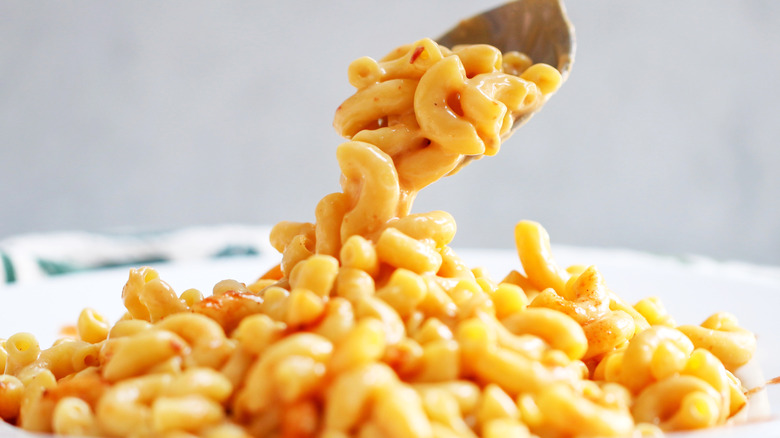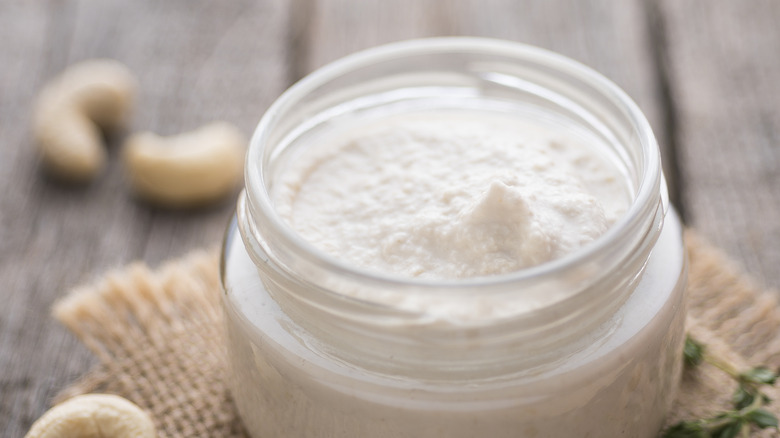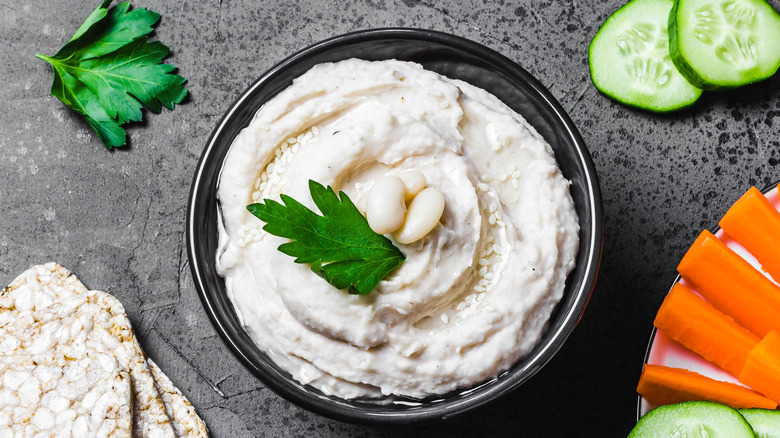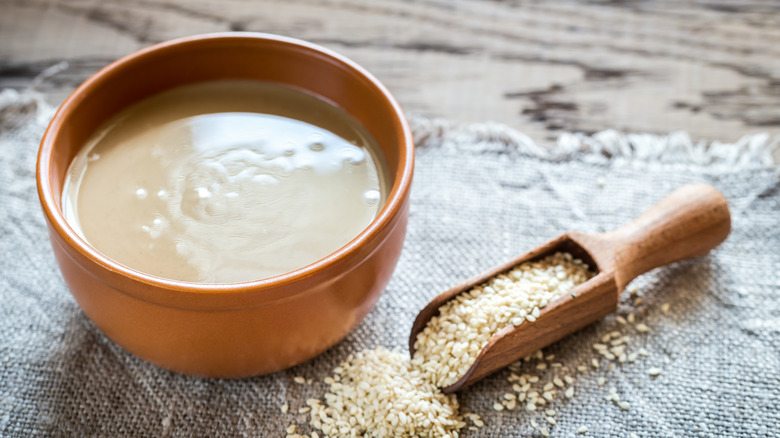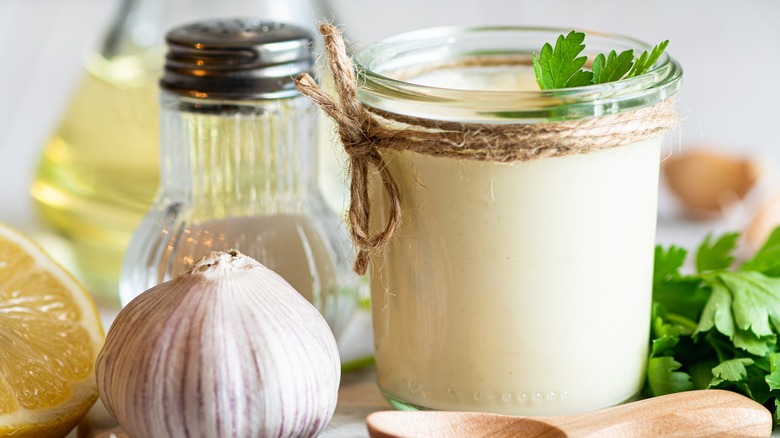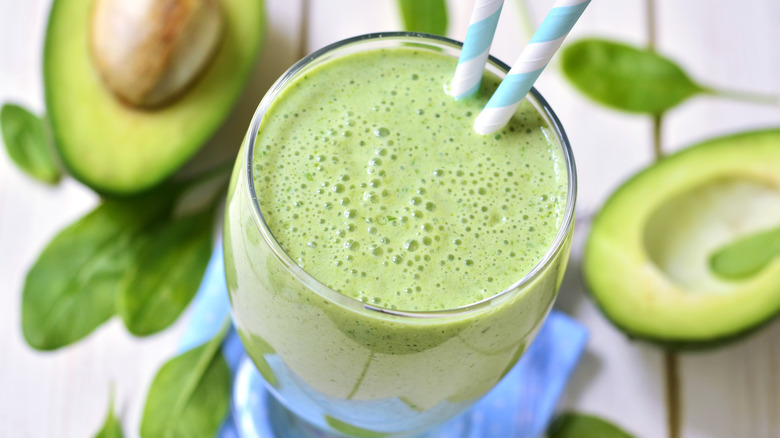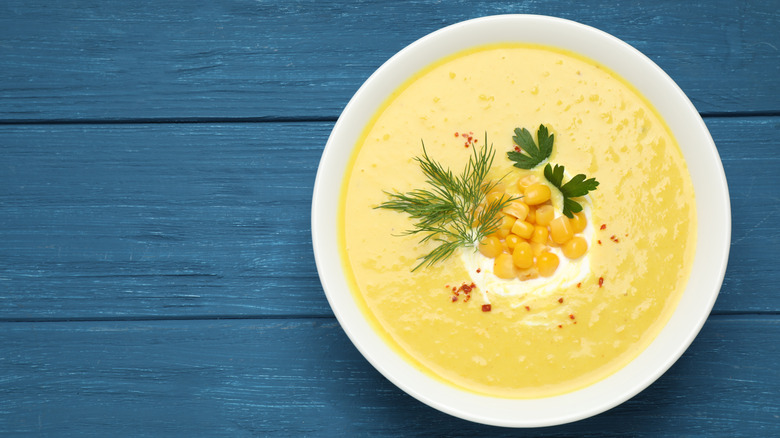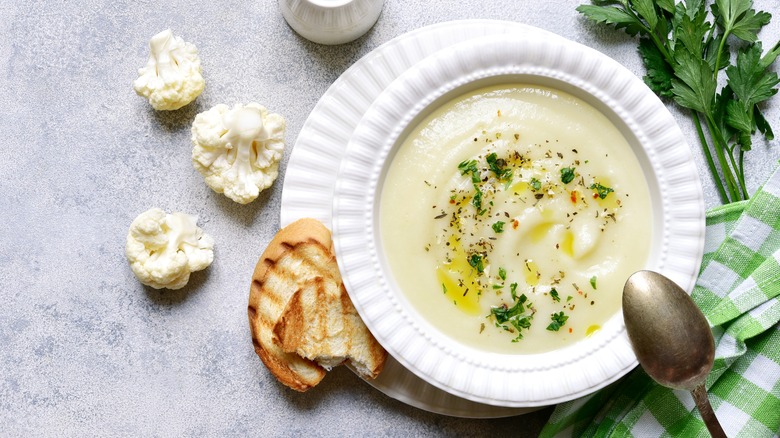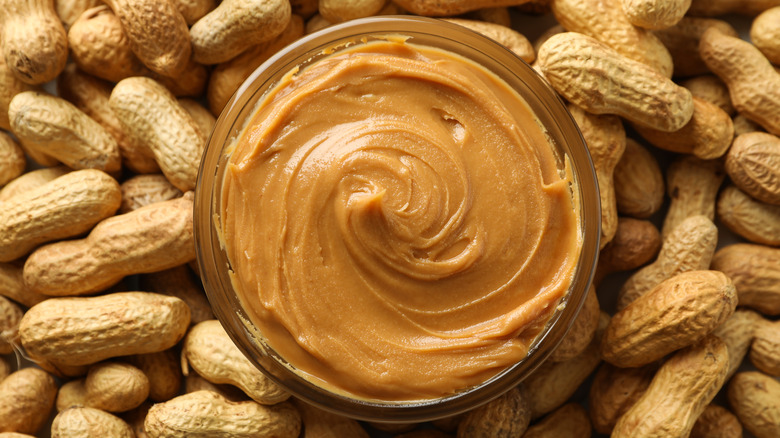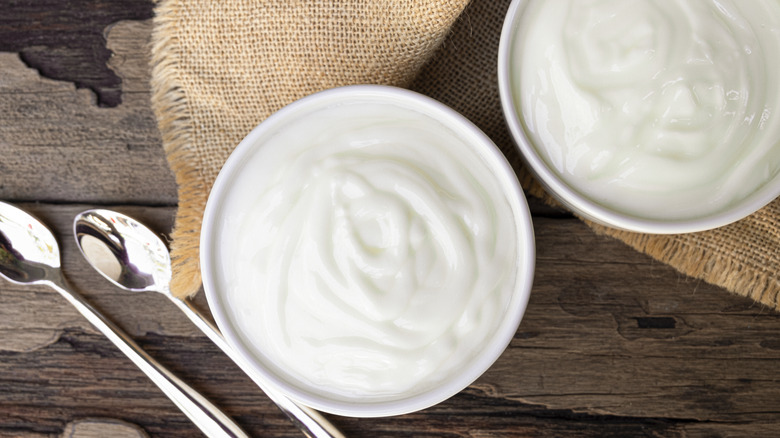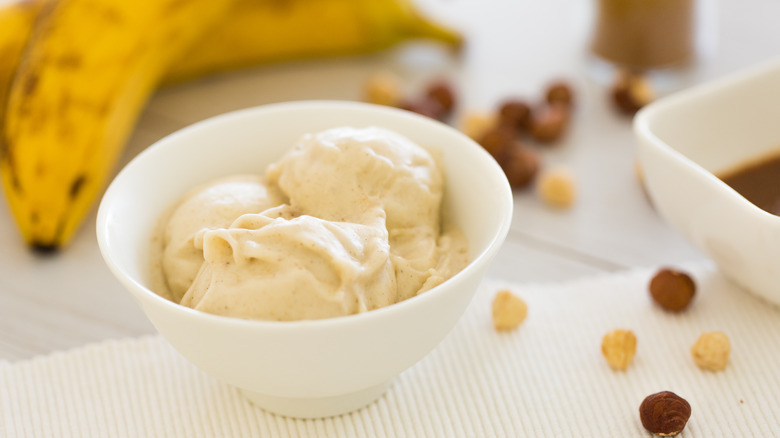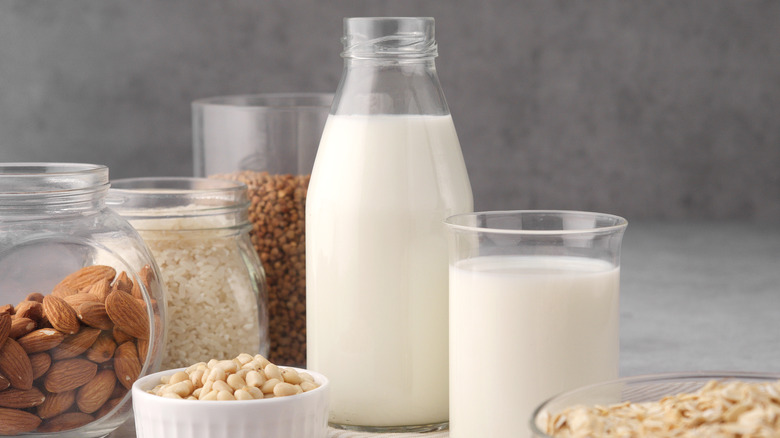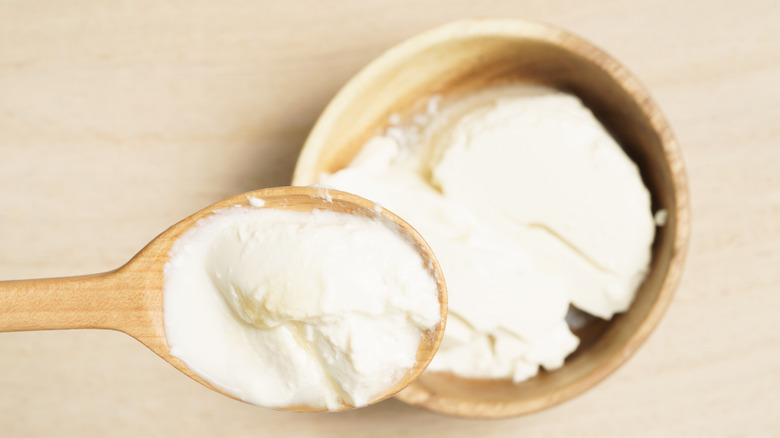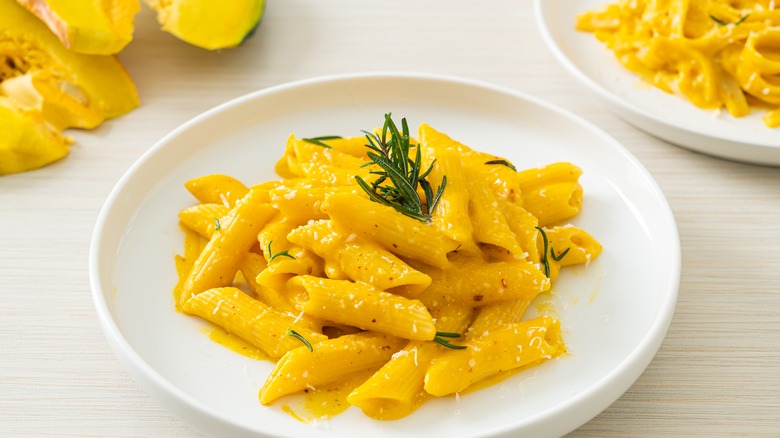14 Dairy-Free Additions For Creamy Dishes
Dairy-free alternatives are slowly but powerfully edging out animal-based milk, cheese, yogurt, and butter. Whether you've given up or reduced dairy in your diet due to stomach issues, a belief system, health reasons, or just trying something new, you're not alone. A new wave of vegan cooking is coming to town, and we couldn't be more excited. As it turns out, dairy-free alternatives can be quite tasty, and, in some cases, incredibly healthy. And while that doesn't mean your coconut milk ice cream is a health food, it does mean less cholesterol and hormones (milk naturally contains growth hormones as its purpose is to help baby cows grow). If you're interested in moving away from dairy, knowing that you don't have to give up your love of cooking or eating is important. Get to know your alternative ingredients, and read up on dairy-free additions for creamy dishes.
That's right, you can still enjoy a version of mac and cheese, ice cream, cream of mushroom soup, whipped cream, mousse, and even grilled cheese without relying on dairy. This isn't the 90s; we certainly don't "got milk" in our glasses anymore. It's time to get blending, puréeing, soaking, and cooking to make the ultimate vegan creamy dishes your dairy-loving taste buds would approve of.
Cashew cream
When you first become vegan, during the inauguration where small birds place a crown made of alfalfa sprouts on your head and meat eaters chant, "Where do you get your protein," you are given the super secret recipe for cashew cream. Okay, it's not that dramatic, but cashew cream is a dairy-free cook's answer to almost any creamy dish. Not only is it incredibly delicious, but it's made with whole foods and is considered healthy. Typically, vegan alternatives can be quite obvious, cashew cream does a great job of blending in when it comes to soups, dressings, pasta sauces, and desserts. Who would have thought that cashews could help to make the perfect vegan pasta sauce that tastes and looks just like Alfredo sauce?
Although it can be intimidating to make the first time, cashew cream is simple. For a basic cream soak raw cashew overnight, or if you are working against the clock just soak them in hot water for about 15 minutes. Drain and pour them into a high-speed blender. Add a squirt of lemon juice, a pinch of sea salt, and just a dash of sugar, maple syrup, or half of a date. Cover with water, blend until creamy, and then blend for another 30 seconds. For a cheese sauce add more salt, lots of nutritional yeast, mustard, garlic powder, onion powder, and white pepper. For a sweet sauce add more sweetener and a dash of vanilla.
Coconut milk
Although Americans love milk, many countries across the world vary rarely incorporate dairy into their diets. Many southeastern Asian cultures opt for the use of coconut milk, as well as Islander nations, and regions where coconuts grow naturally. Coconut milk cooked into a Thai or Indian curry is something you'd find in prevalence in America, along with coconut rice and coconut desserts. It's incredibly creamy and fatty just like cows' milk so it makes a wonderful alternative when it comes to soups and desserts.
Coconut milk has a slightly fruity flavor, but it can certainly be used in savory dishes. Be sure to spring for unsweetened coconut milk, which can usually be found in cans in the Asian section of the grocery store. Pure coconut cream can be chilled and whipped into a stiff and creamy whipped cream, and because it solidifies when chilled, it's often found in icings and ice cream alternatives.
Blended white beans
If you're looking for a protein-packed, fiber-rich alternative to dairy for your savory dish, look no further than white beans. Cannellini or navy beans can be blended into a smooth, dense, creamy paste, a sauce, or even be used to thicken a soup. For pasta sauce, simply sauté your aromatics like garlic and onions in olive oil, then strain and add your can of beans. Let them simmer together and absorb each other's flavors, then pour them into a blender along with additional olive oil, sea salt, and black pepper and blend until creamy. Add vegetable broth as needed. Mix with whole roasted cherry tomatoes, sprinkle with pine nuts, and serve with sautéed mushrooms or vegetables of your choice.
Simply strain the beans and blend until creamy with some of the reserved soup broth for soup. This works exceptionally well for bisques like tomato or roasted red pepper. When using beans in dip, most of us already know what we are doing. Replace mayonnaise or sour cream with blended white beans, and be sure to flavor it with lemon juice, sea salt, and herbs. Of course, blended beans will change the appearance and flavor of your dip, but if you can get yourself to step outside the box of what it should taste like, you might enjoy it even more.
Tahini
Tahini has been gracing us with its presence in soups, salad dressings, and desserts for centuries. It's peanut butter's extra smooth and mild-flavored alternative made entirely from ground sesame seeds. Tahini comes jarred, and when mixed with water becomes incredibly creamy, smooth, and lightens in color, almost to the point where it's off-white. You may have enjoyed tahini over falafel or in a vegan salad before, but its range reaches much further.
Consider using tahini as a shortcut ingredient for a creamy vegan soup. Blend it in for a rich flavor, light color, and creamy mouthfeel. If you're not ready to commit entirely, blend it with water or lemon juice and drizzle it on top of your soup as a garnish. In addition, tahini can be added to smoothies to increase density and creaminess, to dressings to make a delicious vegan ranch dressing or Cesar alternative, and can certainly be spread onto sandwiches in place of mayo. Consider mixing tahini with cocoa powder and maple syrup and spreading it on toast or drizzling it on ice cream as a sweet treat.
Whipped oil
If you're looking for a creamy dressing that doesn't contain buttermilk or eggs, then look no further than oil. You don't need to know absolutely everything about aioli, but did you know it's traditionally made from oil, lemon juice, garlic, and salt? That's right folks, it's vegan and 100% dairy-free. Today, we call any old-flavored mayonnaise aioli, but technically aioli is made with extra virgin olive oil, not mayo. When emulsified with lemon juice the oil becomes creamy and fluffy, and for anyone who's dipped a zucchini fry or chickpea fritter into the sauce, you know just how memorable it can be.
Try making your own aioli at home, or look for a store-bought version made the traditional way, without dairy or eggs. Use it as a spread on sandwiches, dip roasted vegetables into it, mix it into mashed potatoes instead of butter, mix with sriracha and drizzle it on your avocado rolls, dollop it on tacos, or mix it into a salad or grain bowl dressing. It's delicious and when used as a sauce is on par with any dairy-based alternative when it comes to flavor.
Avocado
Avocados have been climbing in popularity alongside veganism. Their fatty, smooth flesh is so irresistible that we are willing to pay a pretty penny to enjoy it on a slice of toast. Avocados do make an incredible topping for Mexican cuisine but are much more versatile than they are often given credit for. Their only downfall is that when they oxidize, they turn rather brown, so it's best to use them fresh.
For a to-die-for pasta sauce, mash an avocado with lemon juice, roasted garlic, sea salt, and black pepper. Top with extra virgin olive oil and stir into cooked spaghetti. Although this recipe might have your Italian great-grandmother rolling over in her grave, it's pretty darn delicious and incredibly creamy. Avocados can also be blended with fresh herbs like basil, chives, and parsley along with lemon juice, a dash of maple syrup, and seasonings to make an incredible salad dressing.
Take a walk on the sweet side and blend frozen avocado chunks into your smoothies along with bananas and non-dairy milk. Add a splash of vanilla and experiences the creamiest milkshake (hold the milk) that you've ever had. Even consider using avocado to ice a cake! Mash it until creamy with maple syrup and lots of cocoa powder. Surprisingly enough, this recipe can fool just about anyone and doesn't contain a hint of dairy.
Potatoes
If you've ever indulged in a cup of potato leek soup, then you can understand just how creamy potatoes can get without the use of dairy. Although they don't share that fatty richness that dairy has, they certainly can get pretty close to mimicking the texture. In order to achieve that heaviness and fatty mouthfeel, simply add olive oil to your cooked and blended potatoes.
Blended potatoes can make any soup incredibly thick and creamy. Take corn chowder for instance. Simply blend half of the diced and boiled potatoes and half of the corn with an emersion or high-speed blender. Both the corn and the potatoes become creamy, and while the potatoes tend to carry a mild flavor, the corn adds a sweetness that can elevate any soup. Of course, don't expect potatoes and corn to do the job of cream, but for a healthy, vegetable-based whole food alternative, they come pretty darn close.
Blended cauliflower
Cauliflower has taken over nearly all of our favorite junk foods. Pizza crust, mashed potatoes, buffalo wings, rice, and now dairy? While cauliflower can't entirely mimic the flavor or texture of dairy, it can help to thicken soups and sauces and deliver a creamy texture. Cauliflower does have a distinctive cruciferous flavor to it, so don't expect it to taste like cream, but certainly consider using it as a healthy, low-fat, high-fiber alternative.
Have you ever had cauliflower mash? Just a touch of roasted garlic, a pinch of sea salt, a dash of crushed black pepper, and a drizzle of EVOO can turn those brain-like white veggies into a creamy dreamy dish that anyone will love. At that point, nobody's going to be asking where the potatoes are. Use the same basic principle by steaming cauliflower and blending it until smooth to make the ultimate soup thickener that's creamy, healthy, and delicious.
Peanut butter
Everyone knows there is no dense creaminess like that of peanut butter. It's a mystery to us why its use is so limited to sandwiches and breakfast foods. Peanut butter pairs with both sweet and savory dishes, and can be used for a range of purposes from taking the heat in your chili down a notch, to adding protein and fat to your plant-based smoothie.
Try using peanut butter in your soups as a thickener. Although this may seem like an odd pick, peanut butter is commonly used in chilis and stews, especially recipes originating in Eastern Asia, and West Africa. Peanut butter can also be added to dressings to enhance their creaminess, and often taste good with Thai flavors like lime and chili sauce. Finally, peanut butter can and should be used in icing to make it unforgettably decedent. Try it paired with dark chocolate cake or cookies.
Vegan yogurt or cheese
Since Greek yogurt proved to us that yogurt was more than just a breakfast food, we've been using it on everything. Top it on soups and tacos, mix it into sauces and dressings, use it as a replacement for cheese and sour cream, and even mix it right into savory dishes. Vegan yogurt is no different, and because of its similar fermentation process, it also carries pro-biotic properties that are great for balancing your gut microbiome.
Use vegan yogurt like you would dairy-based yogurt. Be sure to spring for unflavored and unsweetened varieties, especially if you're going to use them in savory dishes. Like any yogurt, many flavors are loaded with sugar, so it's important to read the label. If you're having trouble getting your hands on unsweetened dairy-free yogurt, look to substitute it with vegan sour cream. Overall, the texture and flavor are quite similar to regular yogurt. Some brands are pretty close to indistinguishable.
Use vegan yogurt in your smoothies, with granola, in channa saag, swirled into bisques, or dolloped on top of Mexican entrées. When considering vegan products as replacements for dairy, give vegan cheeses a try. These days it comes in every variety and can be melted, spread, sprinkled, and even shredded.
Frozen bananas
This health hack might just blow your mind. Did you know you can make one-ingredient ice cream using nothing but frozen bananas? It's sweet, creamy, and delicious all on its own. Simply peel, chop, and freeze a banana overnight in a freezer-safe baggie or Tupperware. Toss it in your food processor and let it mix. This creamy treat will be the same texture as soft-serve and can be enhanced with vanilla extract, peanut butter, cocoa powder, or even other frozen fruits for flavorings.
Don't limit yourself to ice cream when it comes to frozen bananas. Blend frozen bananas with plant-based milk to get the ultimate milkshake. It is utterly indistinguishable from the dairy version, except you'll feel like a million bucks after drinking it. Flavor it how you see fit, but don't worry about adding any sweeteners, because ripe bananas have you covered in the sugar department. This is an amazing hack for those with a sweet tooth or little kids that can't get enough dessert. Mix with peanut butter and cocoa powder for an incredibly decadent peanut butter chocolate shake that you can and should enjoy for breakfast. The next time someone implies that your diet is restrictive, ask them how many times this week they enjoyed a milkshake for breakfast.
Plant-based milk
A decade ago, it was pretty difficult to find dairy-free milk alternatives. Shelf-stable rice milk was just about as good as it got, and even that was tricky to find unless you were at a co-op or Whole Foods Market. Lactaid was saving those with dairy intolerance, and vegans were making the best of what they had. Today, the narrative on dairy-free milk has shifted, and it's beginning to edge out cow's milk, which is so last year.
Nut milk like cashew, macadamia, almond, and pistachio are creamy, accessible, and can be found in both the refrigerator and shelf-stable sections. In fact, more than half of people prefer almond milk to other plant milk alternatives. Oat milk is making its name in the world and is popular amongst vegans and omnivores alike. Some cafes are even making oat milk their default, with cow's milk available upon request. Lesser available sesame and flax milk are loaded with nutrients and healthy fats. A top-tier plant milk, perhaps being the creamiest alternative on the market, is soy milk, which just so happens to also be loaded with protein. Most plant milk is fortified just like cow's milk, so you don't have to worry about missing out on calcium, vitamin D, or other important nutrients. Use them in your cooking and baking, or simply grab a glass for sipping.
Silken tofu
Those who claim to hate tofu are clearly doing it wrong. There is no clearer way to admit you're not a great cook than by saying "tofu is bland." Tofu is a vehicle for flavor, so those with knowledge of sauce and marinade creations should do just fine flavoring the spongy white blocks. You wouldn't forget to season your chicken, would you? For those who have either purposefully or accidentally grabbed a container of silken tofu in the past, you know that its texture is quite unique. Its closest resemblance would be to flan. It's delicate, smooth, structured, and of course bland.
One of the best ways to use silken tofu is to toss it in the blender for a creamy protein boost to your smoothie. Blend it with melted chocolate to make a rich and creamy pudding. Marinade it in vanilla and maple syrup, torch the top, and enjoy creme brûlée. Blend it into a thick soup or bisque for added low-fat, high-protein creaminess. This won't alter the flavor much of your creation, but won't add any strong flavors either. If a recipe calls for cream and you use blended silken tofu instead, you may want to a dash of salt and something sweet to the mixture to help it pass.
Winter squash
Although winter squash might seem like a stretch, think about that amazing sage and butternut squash Alfredo recipe you saw on Pinterest last fall. Roasted butternut, acorn, Delicata, Kabocha, and Hubbard are just a few varieties, along with pumpkins that can blend into an incredibly creamy soup or pasta sauce. Squash is naturally sweet, mild in flavor, and can be relatively inexpensive when they are in season. If you have a backyard, consider growing squash yourself. They are simple to grow and harvest, and, as we know from shopping at farmer's markets, fresh and local always tastes better.
To make a butternut squash pasta sauce, simply peel and roast your squash until tender, and blend it with olive oil, roasted garlic, vegetable broth, salt, and black pepper. Finish cooking your pasta in the sauce, and then top with crispy fried sage leaves and mushrooms roasted in tamari and red wine.
